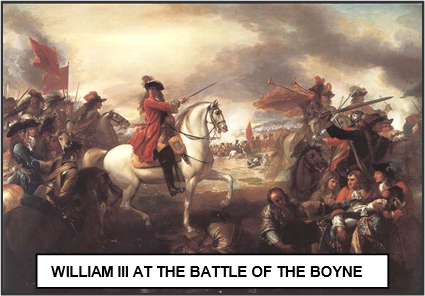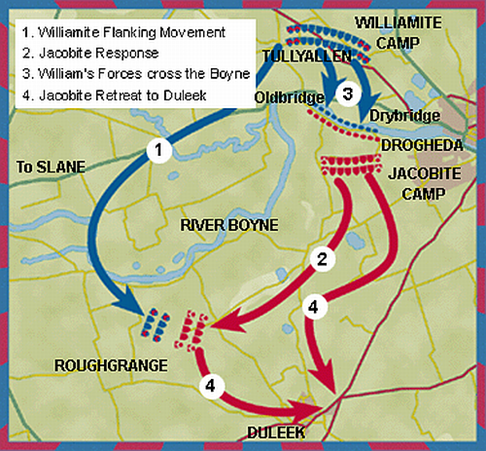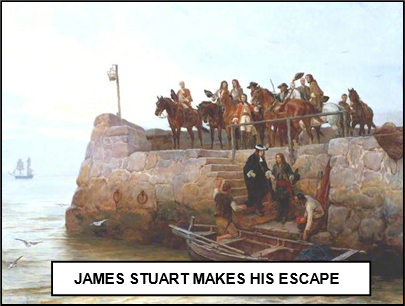


xxxxxIn 1689 the deposed king, James II, as promised, returned to regain his throne. He landed in Ireland and presided over a parliament in Dublin, restoring Catholic lands confiscated since 1641. He then drew up his army of 21,000 -
THE BATTLE OF THE BOYNE 1690 (W3)
Acknowledgements
Boyne: by the American painter Benjamin West (1738-
 xxxxxAs we have seen, when James II fled to France in December 1688 he vowed to return to recapture his rightful throne. True to his word, in March 1689, after obtaining a promise of aid from Louis XIV of France, he landed in Ireland, where he was assured of a large number of Catholic supporters. He laid siege to Londonderry -
xxxxxAs we have seen, when James II fled to France in December 1688 he vowed to return to recapture his rightful throne. True to his word, in March 1689, after obtaining a promise of aid from Louis XIV of France, he landed in Ireland, where he was assured of a large number of Catholic supporters. He laid siege to Londonderry -
xxxxxWilliam III, the newly acclaimed king of Great Britain, landed in Ireland with an army of some 35,000 men, made up of British and Dutch troops and two regiments of Huguenots refugees. He marched south and, on reaching the River Boyne, despatched a force across the river at Rosnaree, a  few miles upstream of James' position. His aim was to encircle the catholic force. The French turned to counter this attack, and William then launched his cavalry across the river in a direct assault upon James' depleted army. The Irish foot soldiers and cavalry fought well, and for a brief while the battle hung in the balance. Eventually, however, William's superior numbers decided the day. They put the Irish and French to flight, and James was once again obliged to escape to France. He had lost a battle and a kingdom. And he also lost 1500 men, whilst the loses on the royalist side were no more than 500.
few miles upstream of James' position. His aim was to encircle the catholic force. The French turned to counter this attack, and William then launched his cavalry across the river in a direct assault upon James' depleted army. The Irish foot soldiers and cavalry fought well, and for a brief while the battle hung in the balance. Eventually, however, William's superior numbers decided the day. They put the Irish and French to flight, and James was once again obliged to escape to France. He had lost a battle and a kingdom. And he also lost 1500 men, whilst the loses on the royalist side were no more than 500.
xxxxxThe Irish forces quickly regrouped, however, and William, proving unable to capture Limerick, returned to England. Itxwas not, in fact, until June of 1691 that his generals, winning the Battle of Aughrim, and then forcing the surrender of Limerick, brought the rebellion to an end. The Glorious Revolution with its Protestant monarch remained in place. ThexTreaty of Limerick of October 1691 was not a particularly harsh settlement. Roman Catholics retained a certain amount of religious freedom, and the land they had held under Charles II was restored to them. However, within a short while the Irish parliament had re-

xxxxxFor James II it was the end of the royal road. There followed a number of plots to overthrow William III, but they came to nothing and James remained in exile until his death in 1701. As we shall see, however, for his followers, the Jacobites, there were to be two further armed attempts to restore the Stuarts to the British throne, the first by his son, the “Old Pretender” in the Fifteen Rebellion of 1715 (G1) and the second by his grandson, the “Young Pretender”, popularly known as Bonnie Prince Charlie, in the Forty-
xxxxxIncidentally, whilst the land battle went William’s way, at sea the French defeated an Anglo-
xxxxx…… The anniversary of the Battle of the Boyne is still celebrated today by the Orangemen of Northern Ireland -
xxxxx…… The painting of the battle above -
W3-


